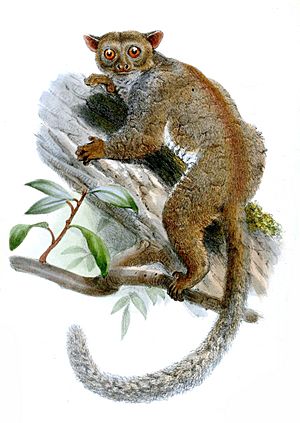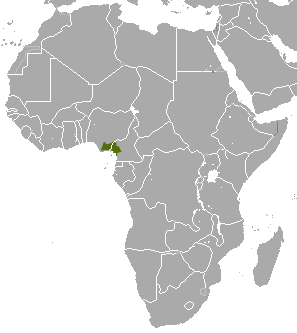Northern needle-clawed bushbaby facts for kids
Quick facts for kids Northern needle-clawed bushbaby |
|
|---|---|
 |
|
| Conservation status | |
| Scientific classification | |
| Genus: |
Euoticus
|
| Species: |
pallidus
|
 |
|
| Northern needle-clawed bushbaby range | |
The northern needle-clawed bushbaby (Euoticus pallidus) is a small, furry primate that lives in trees. It belongs to the Galagidae family, also known as bushbabys or galagos. You can find this animal in the forests near the coast of Cameroon and Nigeria. It also lives on the island of Bioko in Equatorial Guinea. These bushbabies prefer forests where they can find their special food: tree gum and resins.
Contents
About the Northern Needle-Clawed Bushbaby
This bushbaby is a medium-sized animal. Its head and body are about 180 millimeters (7 inches) long. Its tail is a bit longer, around 190 millimeters (7.5 inches). They have long arms and legs, with big hands and feet. Their fur feels soft and woolly.
Special Features of the Bushbaby
The northern needle-clawed bushbaby has a short, blunt nose and large, orange eyes. Bony ridges surround their eyes. A very special feature is their nails. On both their hands and feet, their nails are shaped like a keel (the bottom of a boat). They are long and pointed. These sharp nails help them grip onto large tree branches.
Appearance and Differences
The fur on their upper body and outer limbs is reddish-grey or reddish-buff. It looks greyer on their neck, shoulders, and arms. Some bushbabies have a dark greyish-brown stripe down their back. This stripe runs from their shoulders to the base of their tail. Their tail is the same color as their back, but it gets greyer near the tip. Their belly is yellowish or whitish-grey.
The northern needle-clawed bushbaby looks a lot like the southern needle-clawed bushbaby. However, the northern one has a wide space between its two upper front teeth. Also, its nasal bones (bones in the nose area) are narrower at the front and wider at the back.
Where They Live and Their Home
The northern needle-clawed bushbaby lives in west central Africa. Its home range stretches from the Niger River in Nigeria to the Sanaga River in Cameroon. There are two types, or subspecies, of this bushbaby. One type, E. p. pallidus, lives on the island of Bioko in the Gulf of Guinea. The other type, E. p. talboti, lives in the rest of the area.
Forest Homes
These bushbabies live in wet lowland forests. They can be found in both old, untouched forests and newer forests that have grown back. They usually stay in the upper and middle parts of the trees. They also live in higher, rainy areas like Mount Kupe and Mount Cameroon.
Life and Habits
This bushbaby mostly eats gum that oozes out of tree trunks and branches. They use their special "toothcomb" to get the gum. This toothcomb is made of their enlarged lower front teeth. They also eat invertebrates, which are small creatures like insects. They catch these with both hands. Sometimes, they even hang upside down by two feet while they eat!
Moving Through Trees
Northern needle-clawed bushbabies are very good at climbing. They move around on branches and can even climb down tree trunks headfirst. They can make big jumps between trees. They can also drop straight down, spreading their legs out to slow their fall. They usually look for food alone. However, they talk to each other using sounds. They also sleep together in groups. Not much is known about how they have babies.
Conservation Status
The northern needle-clawed bushbaby might be in danger because its forest home is being destroyed. Forests are being cut down for wood or cleared for farms. This breaks up their habitat into smaller pieces.
Protected Areas
Luckily, some parts of their home are in protected areas. These include the Cross River National Park in Nigeria, and the Korup National Park and Banyang - Mbo Wildlife Sanctuary in Cameroon. The Southern Highlands Scientific Reserve on Bioko island also helps protect them. In 2008, the International Union for Conservation of Nature (IUCN) said this bushbaby was "near-threatened." This means it could become threatened in the future. We don't know if their population is growing or shrinking right now.
See also
 In Spanish: Gálago elegante del norte para niños
In Spanish: Gálago elegante del norte para niños


